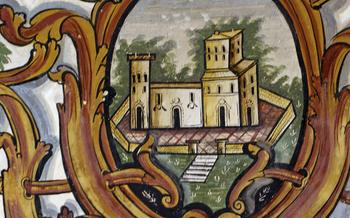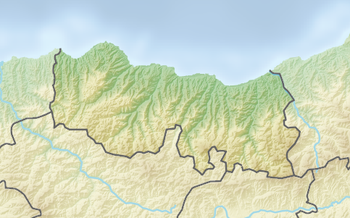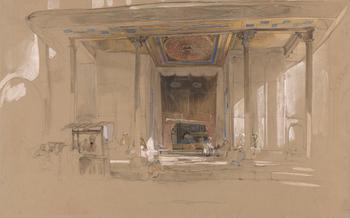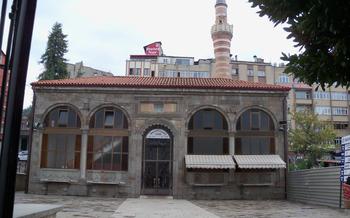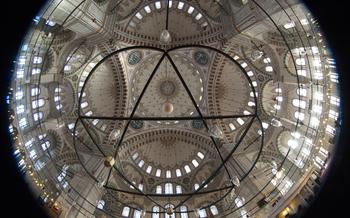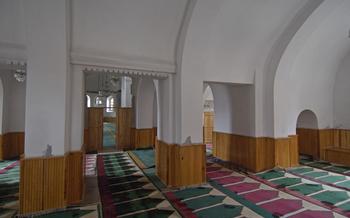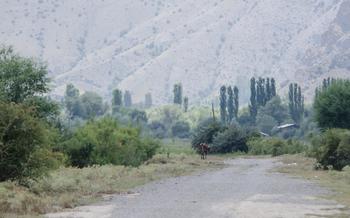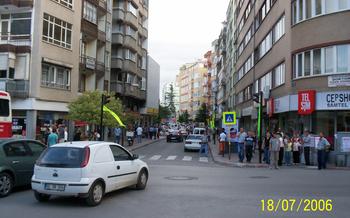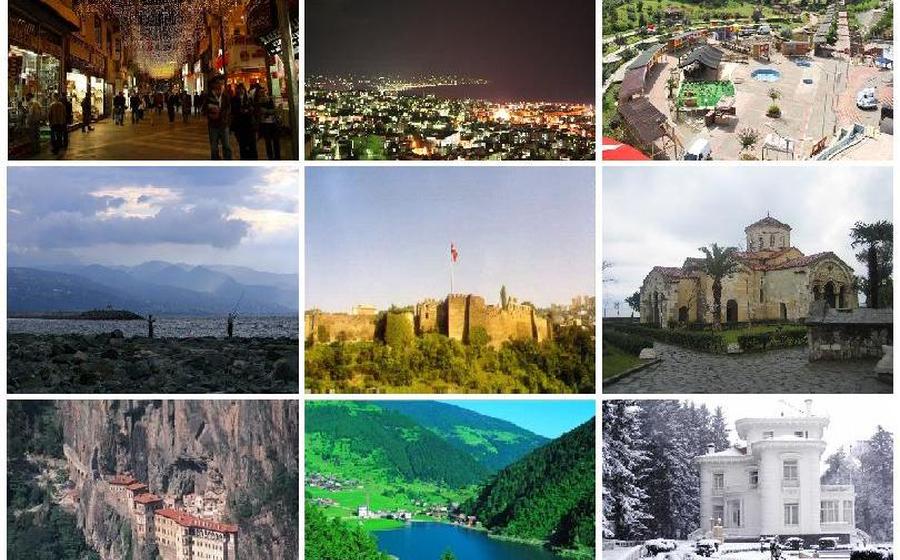
Gülbaharhatun Mosque
- Gülbaharhatun Mosque: An Architectural Masterpiece
- Exploring the Mosque's Interior
- The Story of Gülbaharhatun
- Visiting Hours and Dress Code
- Exploring the Mosque's Courtyard
- Unveiling the Mosque's History
- Nearby Attractions and Landmarks
- Photography Tips and Etiquette:
- Accessibility and Facilities
- Guided Tours and Local Insights
- Unveiling the Neighborhood
- Festivals and Celebrations
- Insider Tip: Hidden Gems
Gülbaharhatun Mosque: An Architectural Masterpiece
The Gülbaharhatun Mosque stands as a testament to the rich architectural heritage of Trabzon. Constructed in 1510 during the reign of Sultan Selim I, this mosque is a prime example of Ottoman architecture, blending Islamic and Byzantine influences. Situated in the heart of Trabzon, it is easily accessible on foot or by public transportation. The mosque's striking features include its intricate stone carvings, colorful tiles, and a majestic central dome. Its unique design elements, such as the multiple minarets and the elegant courtyard, make it a must-visit for anyone interested in Islamic architecture. The mosque has undergone several renovations over the centuries, preserving its grandeur while maintaining its historical essence.
Exploring the Mosque's Interior
Delving into the Gülbaharhatun Mosque's interior is akin to stepping into a realm of intricate artistry and serene spirituality. The walls and ceilings are adorned with intricate tilework and calligraphy, each stroke a testament to the artisans' skill and devotion. The central dome, a majestic architectural feat, soars overhead, its grandeur evoking a sense of awe and reverence. The prayer hall, with its rows of prayer rugs, exudes an aura of tranquility, inviting worshippers to find solace and connection with the divine. The mihrab, the prayer niche indicating the qibla (direction of Mecca), is a masterpiece in itself, featuring exquisite carvings and inscriptions that showcase the mosque's meticulous attention to detail. The acoustics of the mosque are remarkable, with the reverberation of prayers and recitations creating a symphony of sound that enhances the sacred atmosphere. Exploring the mosque's interior is a multisensory experience, leaving visitors with a lasting impression of its beauty, artistry, and spiritual essence.
The Story of Gülbaharhatun
Gülbaharhatun, whose name translates to "Rose Garden Lady," was a remarkable woman who played a pivotal role in the construction of the Gülbaharhatun Mosque. She was the wife of Gazi Hüseyin Paşa, the Ottoman governor of Trabzon in the 15th century. Gülbaharhatun is believed to have been a wealthy and influential woman who used her resources to commission the building of the mosque in memory of her husband.
Legends and anecdotes surrounding Gülbaharhatun add to the mystique of the mosque. One tale suggests that Gülbaharhatun had a dream in which she was instructed to build a mosque in Trabzon. She took this dream as a divine sign and dedicated herself to fulfilling her mission.
The mosque's construction took place during a time when Trabzon was under Ottoman rule. The Ottomans had a significant impact on Trabzon's cultural and architectural landscape, and the Gülbaharhatun Mosque stands as a testament to their influence. The mosque's construction also reflected the growing importance of Trabzon as a regional center within the Ottoman Empire.
Visiting Hours and Dress Code
The Gülbaharhatun Mosque welcomes visitors during specific hours to ensure respectful worship and maintenance. Please plan your visit accordingly to avoid any inconvenience. The mosque's hours of operation typically fall within the morning and afternoon, with occasional closures for special events or holidays. It's advisable to check local sources or contact the mosque directly for the most up-to-date information on visiting hours.
Upon entering the mosque, visitors are expected to adhere to a modest dress code that reflects the sacred nature of the space. While there is no strict dress code enforced, it's customary for both men and women to dress conservatively. Men should avoid wearing shorts, tank tops, or revealing clothing, while women should cover their hair and shoulders. Long, loose-fitting clothing is generally recommended to maintain a respectful demeanor.
Non-Muslim visitors are welcomed with open arms, but it's essential to be mindful of the mosque's religious significance and observe respectful behavior. Please avoid loud conversations, refrain from pointing at religious symbols or artwork, and maintain a quiet and contemplative atmosphere during your visit.
For capturing the mosque's beauty without disturbing worshippers, it's advisable to use a silent camera mode and avoid using flash photography. Be mindful of the people around you, and if you notice someone praying, it's best to refrain from taking photos in their direction. By following these guidelines, you can ensure a respectful and enriching visit to the Gülbaharhatun Mosque.
Exploring the Mosque's Courtyard
Stepping into the courtyard of the Gülbaharhatun Mosque is like entering a tranquil oasis amidst the bustling city. The serene atmosphere, enhanced by the meticulously landscaped gardens, invites visitors to pause and reflect. At the center of the courtyard stands the ablution fountain, a symbol of purification and a reminder of the mosque's religious significance.
The courtyard is not just a place for ablution but also a gathering space for the community. Here, people come together to socialize, exchange stories, and share moments of contemplation. The presence of religious schools or madrasahs within the complex further emphasizes the mosque's role as a center of learning and spiritual guidance.
The courtyard also offers stunning views of the surrounding area. Visitors can admire the mosque's graceful minarets framed against the backdrop of the city skyline. The courtyard's vantage point also allows visitors to appreciate the mosque's intricate architectural details, such as the colorful tiles adorning the dome and the delicate carvings embellishing the walls.
Unveiling the Mosque's History
The Gülbaharhatun Mosque stands as a testament to Trabzon's rich historical tapestry, intricately intertwined with the rise and reign of the Ottoman Empire. Trabzon, once a vibrant port city and a gateway to the Black Sea, fell under Ottoman rule in the 15th century, marking a significant turning point in its history. The Ottomans, renowned for their architectural prowess and cultural legacy, left an indelible imprint on Trabzon, transforming it into a flourishing center of Islamic art and architecture.
The Gülbaharhatun Mosque epitomizes this Ottoman influence, embodying the empire's architectural grandeur and artistic sensibilities. Its construction during the reign of Sultan Bayezid II exemplifies the Ottomans' commitment to expanding their cultural and religious influence throughout their vast empire. The mosque's architectural style, with its distinctive domes, slender minarets, and intricate tilework, reflects the fusion of Ottoman and local traditions, creating a unique blend of architectural styles.
Moreover, the Gülbaharhatun Mosque serves as a poignant reminder of the Ottoman Empire's enduring legacy in Trabzon. As one of the city's most prominent landmarks, it stands as a symbol of Trabzon's rich cultural heritage, showcasing the empire's architectural achievements and its profound impact on the city's development.
Nearby Attractions and Landmarks
The Gülbaharhatun Mosque is surrounded by a wealth of historical sites and landmarks, making it an ideal starting point for exploring Trabzon's rich cultural heritage. The nearby Trabzon Castle, with its imposing fortifications and stunning views of the Black Sea, is a must-visit for history buffs. The Boztepe Hill, accessible by cable car, offers panoramic vistas of the city, the mosque, and the surrounding mountains.
For those interested in religious architecture, the Hagia Sophia, a former Byzantine church converted into a mosque, is a testament to Trabzon's diverse past. The Sümela Monastery, perched dramatically on a cliff overlooking the Altindere Valley, is another architectural marvel that should not be missed. Its well-preserved frescoes and stunning location make it a photographer's paradise.
To delve deeper into Trabzon's history and culture, visitors can explore the Trabzon Museum, which houses a collection of artifacts from the region's past, including the famous "Golden Girl" statue. The vibrant local markets, such as the Bedesten Bazaar, offer a glimpse into the city's bustling trade and provide an opportunity to sample local delicacies and handicrafts.
By combining a visit to the Gülbaharhatun Mosque with these nearby attractions, visitors can create a well-rounded itinerary that showcases the diverse cultural and historical tapestry of Trabzon.
Photography Tips and Etiquette:
When visiting the Gülbaharhatun Mosque, it is important to be respectful of the sacred space and observe proper etiquette. Photography is allowed, but visitors are encouraged to be mindful of the worshippers and maintain a peaceful atmosphere. Here are some tips for capturing the beauty of the mosque while respecting its religious significance:
-
Silent Mode: Before entering the mosque, switch your camera or phone to silent mode to avoid disturbing worshippers with shutter sounds or notifications.
-
Respect Privacy: Avoid taking photos of individuals without their consent, especially during prayer or other religious rituals.
-
Composition: Compose your shots carefully, focusing on architectural details and intricate artwork without blocking the movement of worshippers.
-
Natural Light: Utilize natural light to enhance the beauty of the mosque's interior. The soft, warm light during sunrise or sunset can create stunning photographs.
-
Avoid Flash: Flash photography is generally not allowed inside the mosque, as it can be disruptive and damaging to the delicate artwork and calligraphy.
-
Capture Details: Take your time to capture the mosque's intricate details, such as the colorful tiles, ornate carvings, and beautiful calligraphy.
-
Respectful Posing: When taking photos with people, ask for permission and ensure they are comfortable posing in front of the mosque.
-
Admire in Silence: Sometimes, the best way to appreciate the mosque's beauty is to simply observe it in silence, soaking in the spiritual ambiance and serenity.
Accessibility and Facilities
The Gülbaharhatun Mosque welcomes visitors from all backgrounds and abilities to experience its architectural beauty and spiritual ambiance. Accessibility features ensure that everyone can comfortably explore the mosque.
Wheelchair Accessibility: The mosque is equipped with ramps and accessible pathways, allowing visitors with wheelchairs or mobility aids to navigate the premises seamlessly. Designated prayer areas are also accessible, ensuring that all worshippers can participate in prayer services.
Prayer Facilities: Muslim visitors are provided with dedicated prayer facilities within the mosque. Ablution areas with clean restrooms and wudu facilities are available for both men and women, enabling them to perform ritual cleansing before prayers.
Information Centers: For those seeking further insights into the mosque's history, architecture, and cultural significance, information centers or guides are available. These knowledgeable individuals can provide valuable information and answer any questions visitors may have.
Restrooms and Facilities: The mosque complex includes restrooms and other facilities for the convenience of visitors. These facilities are well-maintained and accessible to everyone, ensuring a comfortable and pleasant experience for all.
Guided Tours and Local Insights
Exploring the Gülbaharhatun Mosque with a knowledgeable guide can greatly enhance your visit. Local guides offer valuable insights into the mosque's history, architecture, and cultural significance. They can provide fascinating anecdotes and explain intricate details that you might miss on your own.
When selecting a guide, look for reputable tour operators or ask for recommendations from your hotel or local tourism offices. Consider pre-booking tours, especially during peak tourist season, to secure your spot.
Guided tours typically cover the mosque's exterior and interior, highlighting architectural features, artwork, and religious symbolism. Guides can also share stories about Gülbaharhatun and her role in the mosque's construction. They can explain the mosque's importance to the local community and its place in Trabzon's rich history.
Whether you choose to join a group tour or hire a private guide, having an expert by your side will transform your visit into a truly immersive and educational experience.
Unveiling the Neighborhood
Beyond the walls of the Gülbaharhatun Mosque, a vibrant neighborhood awaits exploration. Stroll through the narrow cobblestone streets, lined with traditional Ottoman-era houses and local shops. Discover hidden courtyards adorned with colorful flowers and the inviting aromas of freshly brewed Turkish coffee.
Immerse yourself in the neighborhood's daily life by visiting the local market, where vendors proudly display their wares, from fresh produce to handmade crafts. Engage with friendly locals who are always eager to share stories and insights about their community.
Indulge in delicious Turkish cuisine at one of the many nearby restaurants, where you can savor traditional dishes prepared with fresh, local ingredients. Each bite is a testament to the rich culinary heritage of Trabzon.
To truly understand the essence of this neighborhood, take the time to visit the local teahouses, where locals gather to sip çay (Turkish tea) and engage in lively conversations. These teahouses serve as a hub for community interaction, where stories are exchanged, and laughter fills the air.
As you explore the neighborhood, remember to be respectful of local customs and traditions. Dress modestly, greet people with a warm smile and a "Merhaba" (hello), and be mindful of your behavior in public spaces.
By immersing yourself in the neighborhood surrounding the Gülbaharhatun Mosque, you will gain a deeper appreciation for the mosque's significance and the vibrant community that calls this area home.
Festivals and Celebrations
The Gülbaharhatun Mosque, being a significant religious and cultural center in Trabzon, hosts various festivals and celebrations throughout the year, each showcasing the richness of Turkish traditions and Islamic heritage. The most prominent celebration is during the holy month of Ramadan, where the mosque becomes a vibrant hub of spiritual observance and community gatherings. Visitors can witness the beautiful recitation of the Quran, participate in special prayers, and experience the communal spirit of breaking the fast together at sunset. Other festivals celebrated at the mosque include the Mevlid-i Nebi, marking the birth of Prophet Muhammad, and the Laylat al-Qadr, known as the Night of Power, which is considered the holiest night in Islam. During these special occasions, the mosque is adorned with intricate decorations, and special events and ceremonies are held, providing a unique opportunity for visitors to immerse themselves in the religious and cultural tapestry of Trabzon.
Insider Tip: Hidden Gems
Delve deeper into the Gülbaharhatun Mosque and uncover its hidden treasures. Seek out the serene courtyard garden, where the gentle murmur of water from the ablution fountain creates a tranquil oasis. Amidst the intricate tilework and calligraphy, discover subtle details that reveal the artistry and devotion of the mosque's creators. Engage with the locals and inquire about local traditions or practices associated with the mosque. They may share stories of blessings received or rituals performed that have become part of the mosque's rich history. Capture unique perspectives by venturing to the mosque's rooftop, where panoramic views of Trabzon and the surrounding mountains await. From this vantage point, the mosque's architectural grandeur and its harmonious integration with the cityscape become even more apparent. Whether it's a hidden corner for quiet reflection or a breathtaking vista, the Gülbaharhatun Mosque offers countless opportunities for exploration and discovery.
